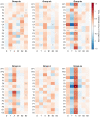Contrasting Electroencephalography-Derived Entropy and Neural Oscillations With Highly Skilled Meditators
- PMID: 33994976
- PMCID: PMC8119624
- DOI: 10.3389/fnhum.2021.628417
Contrasting Electroencephalography-Derived Entropy and Neural Oscillations With Highly Skilled Meditators
Abstract
Meditation is an umbrella term for a number of mental training practices designed to improve the monitoring and regulation of attention and emotion. Some forms of meditation are now being used for clinical intervention. To accompany the increased clinical interest in meditation, research investigating the neural basis of these practices is needed. A central hypothesis of contemplative neuroscience is that meditative states, which are unique on a phenomenological level, differ on a neurophysiological level. To identify the electrophysiological correlates of meditation practice, the electrical brain activity of highly skilled meditators engaging in one of six meditation styles (shamatha, vipassana, zazen, dzogchen, tonglen, and visualization) was recorded. A mind-wandering task served as a control. Lempel-Ziv complexity showed differences in nonlinear brain dynamics (entropy) during meditation compared with mind wandering, suggesting that meditation, regardless of practice, affects neural complexity. In contrast, there were no differences in power spectra at six different frequency bands, likely due to the fact that participants engaged in different meditation practices. Finally, exploratory analyses suggest neurological differences among meditation practices. These findings highlight the importance of studying the electroencephalography (EEG) correlates of different meditative practices.
Keywords: Lempel–Ziv; electroencephalography; entropy; meditation; oscillations; power spectra.
Copyright © 2021 Young, Arterberry and Martin.
Conflict of interest statement
The authors declare that the research was conducted in the absence of any commercial or financial relationships that could be construed as a potential conflict of interest.
Figures


Similar articles
-
Nonlinear EEG signatures of mind wandering during breath focus meditation.Curr Res Neurobiol. 2022 Sep 17;3:100056. doi: 10.1016/j.crneur.2022.100056. eCollection 2022. Curr Res Neurobiol. 2022. PMID: 36518347 Free PMC article.
-
The EEG spectral properties of meditation and mind wandering differ between experienced meditators and novices.Neuroimage. 2021 Dec 15;245:118669. doi: 10.1016/j.neuroimage.2021.118669. Epub 2021 Oct 21. Neuroimage. 2021. PMID: 34688899
-
Network analysis of meditative states in highly skilled meditators using EEG and horizontal visibility graphs.Annu Int Conf IEEE Eng Med Biol Soc. 2024 Jul;2024:1-3. doi: 10.1109/EMBC53108.2024.10782024. Annu Int Conf IEEE Eng Med Biol Soc. 2024. PMID: 40039552
-
From alpha to gamma: electrophysiological correlates of meditation-related states of consciousness.Med Hypotheses. 2010 Aug;75(2):218-24. doi: 10.1016/j.mehy.2010.02.025. Epub 2010 Mar 12. Med Hypotheses. 2010. PMID: 20227193 Review.
-
The neuroscience of meditation: classification, phenomenology, correlates, and mechanisms.Prog Brain Res. 2019;244:1-29. doi: 10.1016/bs.pbr.2018.10.020. Epub 2019 Jan 16. Prog Brain Res. 2019. PMID: 30732832 Review.
Cited by
-
Nonlinear EEG signatures of mind wandering during breath focus meditation.Curr Res Neurobiol. 2022 Sep 17;3:100056. doi: 10.1016/j.crneur.2022.100056. eCollection 2022. Curr Res Neurobiol. 2022. PMID: 36518347 Free PMC article.
-
Inducing a meditative state by artificial perturbations: A mechanistic understanding of brain dynamics underlying meditation.Netw Neurosci. 2024 Jul 1;8(2):517-540. doi: 10.1162/netn_a_00366. eCollection 2024. Netw Neurosci. 2024. PMID: 38952817 Free PMC article.
-
Meditation and complexity: a review and synthesis of evidence.Neurosci Conscious. 2025 May 28;2025(1):niaf013. doi: 10.1093/nc/niaf013. eCollection 2025. Neurosci Conscious. 2025. PMID: 40438122 Free PMC article. Review.
-
Mindfulness-Based Cognitive Therapy in Clinical Practice: A Systematic Review of Neurocognitive Outcomes and Applications for Mental Health and Well-Being.J Clin Med. 2025 Mar 3;14(5):1703. doi: 10.3390/jcm14051703. J Clin Med. 2025. PMID: 40095733 Free PMC article. Review.
-
Neurophysiological mechanisms of focused attention meditation: A scoping systematic review.Imaging Neurosci (Camb). 2025 May 28;3:IMAG.a.14. doi: 10.1162/IMAG.a.14. eCollection 2025. Imaging Neurosci (Camb). 2025. PMID: 40800838 Free PMC article.
References
LinkOut - more resources
Full Text Sources
Other Literature Sources

